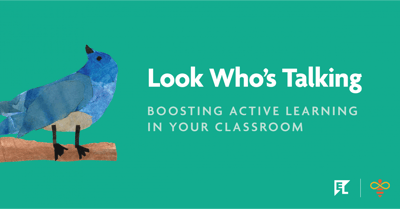By Christina Riley, EL Education
 There’s no better indicator of the quality of learning taking place in the classroom than the quality of student discussion.
There’s no better indicator of the quality of learning taking place in the classroom than the quality of student discussion.
In a fifth-grade classroom in Atlanta, Georgia, students are sitting in a circle animatedly discussing what they can do to preserve the rainforest. They all clutch pages of research notes, which they frequently refer to for evidence throughout the discussion.
“Let’s hold a bake sale to raise money for a rainforest organization,” suggests one boy. “That’s a good idea,” a girl enthusiastically responds, “but money won’t replace the trees being cut down.” She goes on to ask the group how many of them eat frozen pizza or use body lotion. After quickly surveying the number of raised hands, she informs them that these products, as well as many others they can find at home, contain palm oil derived from the rainforest. She concludes by recommending everyone in the group commit to avoiding purchasing products containing palm oil; that would significantly help the rainforest. Other students in the discussion group show the ‘me too’ hand signal, make noises of agreement, and add notes to their note-catchers.
Student observers sitting around the outside of the discussion circle furiously take notes about what they see and hear on clipboards to provide feedback to their peers after the discussion. ‘Balance air time for everyone to get a chance to speak’, is noted by an observer after one boy interrupts another to contribute to the discussion for the third time in as many minutes.
This activity is from “Biodiversity in the Rainforest,” a module in the EL Education K–5 Language Arts curriculum. Students began the module by closely reading and analyzing informational texts about why rainforests are important, including why scientists study the rainforest. The Science Talk described above was an opportunity for students to discuss what they learned through a short online research project in order to generate a plan of action for service work.
Science Talks
Engaging Science Talks like this in the EL Education K–5 Language Arts curriculum are discussions led by students about meaningful questions. Having read and researched information on a science topic, students get the chance to collectively theorize, build on each other’s ideas, work out misconceptions, and learn about scientific discourse. Most importantly, Science Talks allow all students to do exactly what scientists do: think about, wonder about, and talk about how things work. These talks provide a window into student thinking that can help teachers figure out what students really know and what misconceptions they have before they create written products about the issues being discussed.
Protocols
Protocols, like Science Talks, are an important feature of our curriculum because they engage students in discussion, inquiry, critical thinking, and sophisticated communication. A protocol consists of agreed-upon, detailed guidelines for reading, recording, discussing, or reporting that promotes equity by ensuring every student in the class participates equally. We use protocols a lot in the curriculum, because they get all students talking and invite them to value different perspectives and new insights; importantly, protocols require students to talk to each other, not just the teacher. After reading, thinking, and talking, students are better equipped to put their ideas into writing.
Supporting All Students
Speaking and listening protocols are especially useful for scaffolding the learning experience for students with learning challenges and English Language Learners (ELLs). These students, who may struggle with reading grade-level texts, will likely be able to contribute to conversations and discussions when using an appropriate discussion protocol. The repeated academic and procedural language of protocols also facilitates language acquisition. Sentence stems for academic conversation and asking questions, norms for honoring diverse perspectives, and procedures for synthesizing contributions to a discussion hold individuals and groups accountable for pushing their thinking further.
As teachers and students gain comfort with these protocols, classroom discussions get deeper, richer, and more fun for all involved. We hope they will be used to get all students talking even more during the rest of the school day, even beyond literacy lessons.

